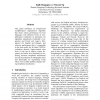Free Online Productivity Tools
i2Speak
i2Symbol
i2OCR
iTex2Img
iWeb2Print
iWeb2Shot
i2Type
iPdf2Split
iPdf2Merge
i2Bopomofo
i2Arabic
i2Style
i2Image
i2PDF
iLatex2Rtf
Sci2ools
NAACL
2007
2007
High-Performance, Language-Independent Morphological Segmentation
This paper introduces an unsupervised morphological segmentation algorithm that shows robust performance for four languages with different levels of morphological complexity. In particular, our algorithm outperforms Goldsmith’s Linguistica and Creutz and Lagus’s Morphessor for English and Bengali, and achieves performance that is comparable to the best results for all three PASCAL evaluation datasets. Improvements arise from (1) the use of relative corpus frequency and suffix level similarity for detecting incorrect morpheme attachments and (2) the induction of orthographic rules and allomorphs for segmenting words where roots exhibit spelling changes during morpheme attachments.
Computational Linguistics | Incorrect Morpheme Attachments | Morpheme Attachments | Morphological Segmentation Algorithm | NAACL 2007 |
| Added | 30 Oct 2010 |
| Updated | 30 Oct 2010 |
| Type | Conference |
| Year | 2007 |
| Where | NAACL |
| Authors | Sajib Dasgupta, Vincent Ng |
Comments (0)

